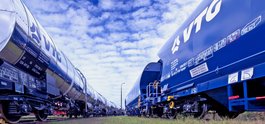More and more companies are opting to shift their freight transports from road to rail. As this example of an airport operator shows, the environment is not the only beneficiary: Efficiency improves, too.
The fuel used in jet aircraft is traditionally delivered to airports by road. Indeed, since most airports do not have railway sidings, road haulage is their only option. But one VTG customer, keen to know whether this arrangement could be changed in the interests of sustainability, discovered that the transport concept developed by VTG not only helps mitigate climate change buy also yields added advantages. You cannot make a railway siding out of thin air, so it was part of the concept to at least use rail to the greatest extent possible: Special tank containers would be filled with jet fuel and transported to the terminal nearest the airport by modular VTG freight wagons. Here, the containers would than be transferred onto trucks to shuttle the last mile back and forth to the airport.
Avoiding CO2 emissions while increasing payloads
This switch saves a considerable amount of CO2: 125 tons, based on the distances and cargo volumes used in our scenario. In addition, the multimodal solution also significantly increases payload. In the context of multimodal transport, each tank container can carry four tons more jet fuel compared to using only road transport. Payback is therefore rapid and substantial. An added bonus is that the cargo can be temporarily stored at the terminal and taken to the airport at any time of the day or night, when it is needed.
Safe unloading
In our case study, VTG’s multimodal offerings also included suitable tank containers. Here, it was important to use what are known as ground-operated containers: When unloading a tank container, the valves must first be opened at the top of the container to avoid a vacuum. In the past, the truck driver had to climb on top of the container to open the valves by hand – a not insignificant risk factor, especially in bad weather. With ground-operated containers, however, the valves can be opened from ground level: There is no need for anyone to do any climbing.
This holistic service offered by VTG is yet another example of the potential of modal shift, which benefits customers and the environment alike.





